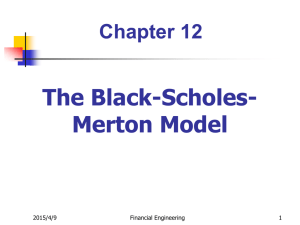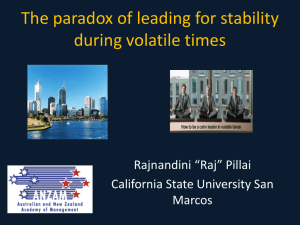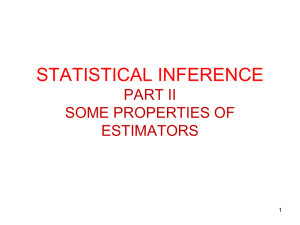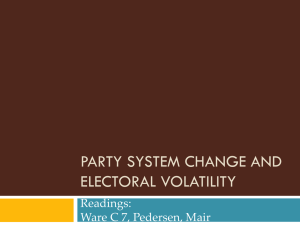5-Portfolio-Theory
advertisement
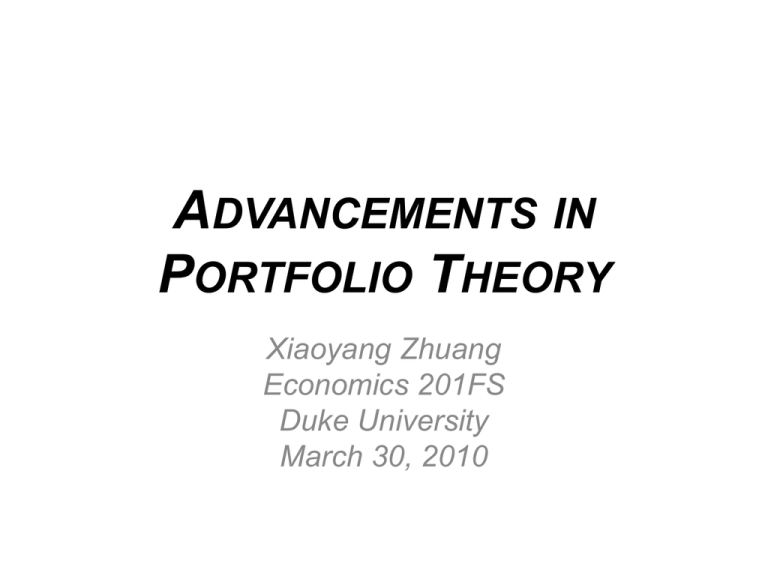
ADVANCEMENTS IN PORTFOLIO THEORY Xiaoyang Zhuang Economics 201FS Duke University March 30, 2010 Contents 1. Fleming, Kirby, Ostdiek (2003) with our own data A review of their methodology Original results using high-frequency U.S. equities 2. Future Directions Fleming, Kirby, and Ostdiek (2003, JFE) The Economic Value of Volatility Timing Using “Realized” Volatility SETTING min(α) σ2 = αΣtα subject to αTe = 1, αT = P •Risk-averse investor within a “conditional” mean-variance framework •Four asset classes: stocks, bonds, gold, and cash •Daily rebalancing •Allocation is implemented using futures on the risky assets (makes analysis robust to transaction costs and trading restrictions) CONCLUSION Given the daily estimator, an investor would be willing to pay 50-200 bps/year to upgrade to the 5minute RV/RCov estimator. Fleming, Kirby, and Ostdiek (2003, JFE) The Economic Value of Volatility Timing Using “Realized” Volatility ESTIMATORS •Covariance Using Daily Returns. where Ωt-k is a symmetric N x N matrix of weights, and et-k = (Rt-k – ) is an N x 1 vector of daily return innovations. The weights are exponential. Certain choices of Ωt-k causes the estimate to resemble the estimate generated by a multivariate GARCH model. •Covariance Using 5-Minute Returns. Realized Covariance. •Returns. According to the authors, assuming a constant returns vector is empirically sound. Fleming, Kirby, and Ostdiek (2003, JFE) The Economic Value of Volatility Timing Using “Realized” Volatility MEASURING PERFORMANCE GAINS •Quadratic Utility Approach •Each day, the investor places some fixed amount of wealth W0 into cash (6%(!!!) risk-free rate assumed) and purchases futures contracts with the same notional value. Her daily utility is where Rpt is the portfolio‘s return (on day t), γ is the investor’s RRA, and Rf is the risk-free rate. •Define Rp1t and Rp2t as the portfolio’s return using high- and low-frequency estimators, respectively, in making the allocation decision. The (daily) performance gain from using high-frequency estimators is then ∆, such that Fleming, Kirby, and Ostdiek (2003, JFE) The Economic Value of Volatility Timing Using “Realized” Volatility MEASURING PERFORMANCE GAINS •Quadratic Utility Approach •Each day, the investor places some fixed amount of wealth W0 into cash (6%(!!!) risk-free rate assumed) and purchases futures contracts with the same notional value. Her daily utility is where Rpt is the portfolio‘s return (on day t), γ is the investor’s RRA, and Rf is the risk-free rate. •Define Rp1t and Rp2t as the portfolio’s return using high- and low-frequency estimators, respectively, in making the allocation decision. The (daily) performance gain from using high-frequency estimators is then ∆, such that FKO With Our Own Data MEASURING PERFORMANCE GAINS •Five stocks: Alcoa (AA), DuPont (DD), Ford (F), JPMorgan Chase (JPM), Wal-Mart (WMT) •Target return: 5% •Lags for the rolling estimator = 5 •Decay rates for rolling estimator: [0.030 (daily) 0.060 (RV)] •Risk-free rate = 6% (as per FKO) •γ = 10 (1) (2) Benefits of High-Frequency Data Benefits of High-Frequency Data STATISTICS: WHOLE PERIOD (%) mean(PerfGain) = 14.6057 median(PerfGain) = 14.6566 std(PerfGain) = 3.4371 range(PerfGain) = [-22.7854 76.2392] STATISTICS: 9/1/2008 – 12/25/2008 (%) mean(PerfGain) = 15.1245 median(PerfGain) = 15.2262 std(PerfGain) = 8.6467 range(PerfGain) = [-22.7854 44.4357] Short-Selling STATISTICS: RV ESTIMATOR (%) mean(sum(α)) = 31.51 median(sum(α)) = 31.27 std(sum(α)) = 7.81 range(sum(α)) = [6.89 68.69] STATISTICS: GARCH-Y ESTIMATOR (%) mean(sum(α)) = 23.59 median(sum(α)) = 23.32 std(sum(α)) = 109.46 range(sum(α)) = [-2623.40 1078.70] Short-Selling STATISTICS: RV ESTIMATOR (%) mean(sum(α)) = 31.51 median(sum(α)) = 31.27 std(sum(α)) = 7.81 range(sum(α)) = [6.89 68.69] STATISTICS: GARCH-Y ESTIMATOR (%) mean(sum(α)) = 23.59 median(sum(α)) = 23.32 std(sum(α)) = 109.46 range(sum(α)) = [-2623.40 1078.70] Questions Moving Forward On Portfolio Optimization: How and When Do We Benefit From High-Frequency Data? What accounts for the different leverage recommendations between the GARCH-y and multivariate RV measures? What accounts for the unpredictable performance differences between GARCH-y and multivariate RV measures in periods of market stress? Compare with Extreme Value Estimators? How clueless are fund of fund managers? Are there any benefits of “volatility timing” for fund of fund managers who know the asset class, but not the individual assets, that their fund managers are investing in?




